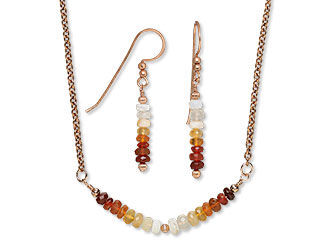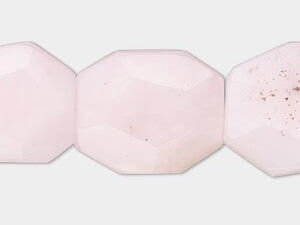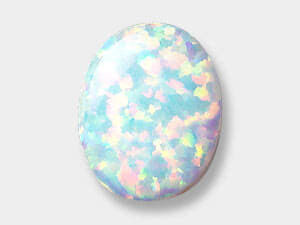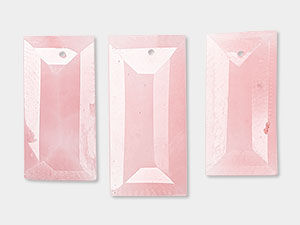Opal Meaning and Properties
Opal History
The name "opal" comes from the Sanskrit word upala, meaning precious stone. In Indian mythology, the virgin Goddess of the Rainbow was turned into an opal by the Mother Goddess because she was being chased by suitors Brahma, Vishnu and Shiva. Ancient Greeks thought the stone could give people the gift of prophecy and protected them from disease. During Roman times, the Latin word opalus came into use.
Opal is now associated with the birthstone of October (along with pink tourmaline) and as the gemstone of the 14th marriage anniversary. While some people believe it is unlucky for people not born in October to wear opal, the gemstone has actually long been valued as a stone of luck and magic. Opal is also an alternative birthstone for April babies.
You can learn more about the different varieties of opal with these addtional resources:
- Dendritic Opal Meaning and Properties
- Peruvian Opal Meaning and Properties
- Ethiopian Opal Meaning and Properties
Watch this video and learn about the magic and mystique of opals with our host, Susanne. Bonus! She's inviting Patti to share how to make a celestial-themed opal necklace that anyone can create in minutes.

Opal Metaphysical Properties
It is said that precious opal, with its display of fire, can spark creativity, and that the "dance" of its fire can help people enjoy their lives. The light-colored gemstones have long been associated with helping people become less visible to others and also in improving eyesight. The gemstone has been associated with the sacral chakra, imbalances of which can cause problems with addictions. Some people believe that opal can help moderate and harmonize sexual desires. European cultures have long believed opal is a symbol of hope, purity and truth.
Opal Geological Properties
Opals come in three natural varieties: precious opal, fire opal and common opal.
- Precious opals are prized for their play-of-color—rainbow-like flashes caused by light reflecting off microscopic silica spheres within the stone. This iridescent effect is called interference and gives precious opals their magical “fire.” These opals occur in shades from milky white to dark gray, blue, or black.
- Fire opals are named for their body color rather than optical effects. Found primarily in Mexico, fire opals range from yellow to orange-red. They may be transparent or milky but do not typically exhibit play-of-color.
- Common opals, also known as “potch,” do not display play-of-color but are still captivating in their own right. These generally opaque stones form under the same conditions as precious opals but lack the internal structure needed for interference. Common opals occur in a wide range of natural hues—including white, green, pink, purple, blue and even tan or brown.
Some of the most popular varieties include Peruvian pink opal, often seen in soft, pastel tones, and green common opal, which offers a serene, earthy look. Unlike their fiery counterparts, common opals tend to have a waxy or pearly luster and are favored for their smooth surface and soothing appearance.
Opals are found in the veins and cavities of igneous or sedimentary rock. The finest opals come from Australia, though notable deposits also exist in Brazil, Mexico, Ethiopia, the Czech Republic, Slovakia, southern Africa and Nevada, USA.
- Mineral Information: hardened silica gel with water content
- Chemical Composition: SiO2-nH2O2
- Color: transparent to opaque, all colors
- Hardness: 5-1/2 to 6-1/2 (Mohs)
- Specific Gravity: 1.98 - 2.20
- Refractive Index: 1.450
Proper Care of Opal
Opal is a fairly soft stone and can be damaged by steam or ultrasonic cleaning machines and harsh chemicals. The best way to clean opal is with a soft, untreated cloth and mild soapy water. It is recommended to not submerge the gemstone in soapy water. While solid opals won't be damaged by submersion, doublet or triplet opals (non-solid, man-made opal stones) can be. Gently pat dry and be sure jewelry is completely dry before storing or wearing. Store opal jewelry away from other pieces of jewelry as metals and harder gemstones can cause damage to the softer stone.
Designing with Opal
Precious and Gilson imitation opals display a unique visual phenomenon--they flash rainbow-like colors. Depending on the background color and the predominant "fire" display color, opals can be "framed" by either silver or gold. The natural iridescent luster of pearls complements the fire of opals. White opals work well with light, pastel-colored gemstones. Dark opals can be beautifully mixed with darker stones that match the opal's background color or that pick up the flashing colors. Natural opal gemstone is soft and works better in earrings or pendants than when used in bracelets or rings that could experience impact and scratches.
Fire opals are yellow to orange-red and do not display fire. For a startling complementary color scheme, mix the orange-red fire opal with a greenish-tinted turquoise or Crystal Passions®. Or, try combining fire opal with gemstones that are close in hue: citrine, carnelian and red aventurine. A beautiful harmony is created by a split-complementary scheme: fire opal with blue and green aventurine.
A Few Design Inspirations to Get You Started
Shop for Opal
**Please note that all metaphysical or healing properties listed are collected from various sources. This information is offered as a service and not meant to treat medical conditions. Fire Mountain Gems and Beads® does not guarantee the validity of any of these statements.
How did you like this resource? Your feedback helps us provide resources that matter to you most.
Copyright Permissions
All works of authorship (articles, videos, tutorials and other creative works) are from the Fire Mountain Gems and Beads® Collection, and permission to copy is granted for non-commercial educational purposes only. All other reproduction requires written permission. For more information, please email copyrightpermission@firemtn.com.






